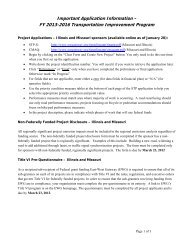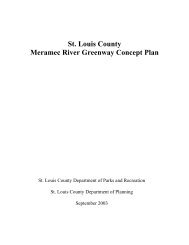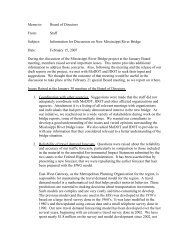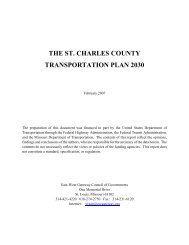Jefferson County - East-West Gateway Coordinating Council
Jefferson County - East-West Gateway Coordinating Council
Jefferson County - East-West Gateway Coordinating Council
Create successful ePaper yourself
Turn your PDF publications into a flip-book with our unique Google optimized e-Paper software.
A Regional Overview All-Hazard Mitigation Plan 17<br />
Over 1,000 flood warnings and statements, five times the normal, were issued to notify the<br />
public and need-to-know officials of river levels. In St. Louis, river levels were nearly 20 feet<br />
above flood stage, the highest in the city’s 150-year history. The 52-foot St. Louis Flood<br />
wall, built to handle the volume of the 1844 flood, was able to keep the 1993 flood out<br />
with just over two feet to spare. On the Missouri River it was estimated that nearly all of<br />
the 700 privately built agricultural levees were overtopped or destroyed. Navigation on the<br />
Mississippi and Missouri River had been closed since early July resulting in a loss of $2<br />
million (1993) dollars per day in commerce.<br />
The Mississippi River at St. Louis crested at 49.6 feet on August 1, nearly 20 feet above<br />
flood stage and had a peak flow rate of 1.08 million cubic feet per second. The old record<br />
was 43.2 feet in 1973. Some locations on the Mississippi River were in flood for almost<br />
200 days while locations on the Missouri neared 100 days of flooding. On the Mississippi<br />
River, Grafton, Illinois recorded flooding for 195 days, Clarksville, Missouri for 187 days,<br />
Winfield, Missouri for 183 days, Hannibal, Missouri for 174 days, and Quincy, Illinois for<br />
152 days. The Missouri River was above flood stage for 62 days in <strong>Jefferson</strong> City, Missouri,<br />
77 days at Hermann, Missouri and for 94 days at St. Charles in the St. Louis metropolitan<br />
area. On October 7, 103 days after it began, the Mississippi River at St. Louis finally<br />
dropped below flood stage.<br />
According to the U.S. Army Corps of Engineers (as noted in the NOAA National Weather<br />
Service disaster survey report) 40 of 229 federal levees and 1,043 of 1,347 non-federal<br />
levees were over-topped or damaged. Every breeched levee contributed to the amount of<br />
floodwater flowing outside the main drainages. The flood eroded more than 600 billion<br />
tons of topsoil and deposited great amounts of sand and silt on valuable farmland. In large<br />
areas inundated by the flood, the harvest of 1993 was a total loss and some farmers lost<br />
any chance for a 1994 harvest.<br />
At St. Louis, the first spring flooding on the Mississippi River was recorded April 8, cresting<br />
at 0.2 feet above flood stage and lasting only that day. The Mississippi rose above flood<br />
stage again on April 11 and stayed above flood stage until May 24. The city got a respite<br />
as the Mississippi stayed below flood stage May 24 to June 26. On June 27, the Mississippi<br />
again went above flood stage and did not drop below flood stage until October 7—a total<br />
of 146 days above flood stage. The Mississippi River was above the old record flood stage<br />
for more than three weeks at St. Louis from mid July to mid August. Prior to 1993, the<br />
historic flood of record on the Mississippi River at St. Louis had been 43.2 feet, recorded<br />
April 28, 1973. That record was broken July 21, 1993, with a level of 46.9 feet and broken<br />
again 11 days later with a record stage of 49.58 feet on Aug. 1. St. Louis is located near<br />
the confluence of the Missouri, Illinois and Mississippi rivers, all of which were in flood at<br />
the same time.<br />
From April through October, 1993, flooding of the Upper Mississippi River and the<br />
Missouri River caused a national catastrophe, interrupting transcontinental commerce for<br />
many weeks, including rail, highway and barge traffic. Tremendous outlays of local, state<br />
and federal dollars to aid recovery of people and property created major financial

















